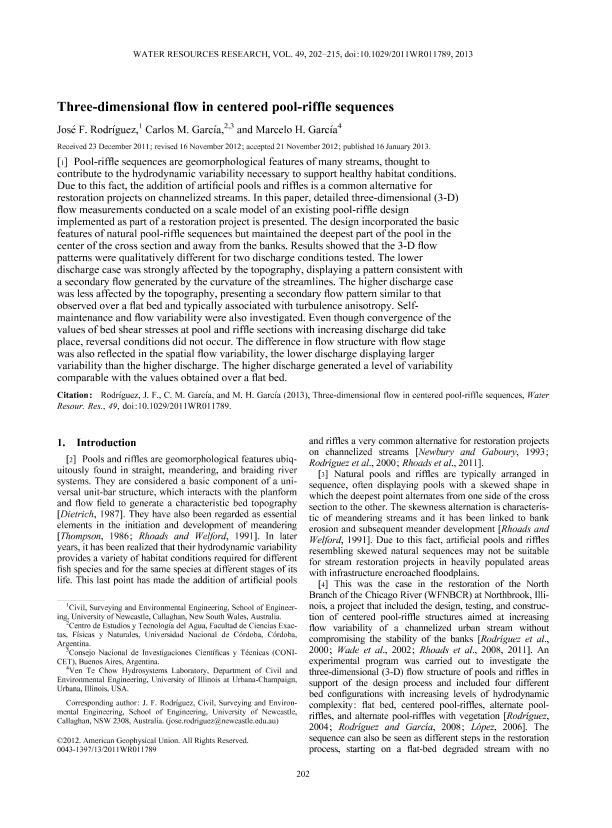Mostrar el registro sencillo del ítem
dc.contributor.author
Rodríguez, José F.
dc.contributor.author
Garcia Rodriguez, Carlos Marcelo

dc.contributor.author
García, Marcelo Horacio

dc.date.available
2019-07-11T14:16:25Z
dc.date.issued
2013-01
dc.identifier.citation
Rodríguez, José F.; Garcia Rodriguez, Carlos Marcelo; García, Marcelo Horacio; Three-dimensional flow in centered pool-riffle sequences; American Geophysical Union; Water Resources Research; 49; 1; 1-2013; 202-215
dc.identifier.issn
0043-1397
dc.identifier.uri
http://hdl.handle.net/11336/79344
dc.description.abstract
Pool-riffle sequences are geomorphological features of many streams, thought to contribute to the hydrodynamic variability necessary to support healthy habitat conditions. Due to this fact, the addition of artificial pools and riffles is a common alternative for restoration projects on channelized streams. In this paper, detailed three-dimensional (3-D) flow measurements conducted on a scale model of an existing pool-riffle design implemented as part of a restoration project is presented. The design incorporated the basic features of natural pool-riffle sequences but maintained the deepest part of the pool in the center of the cross section and away from the banks. Results showed that the 3-D flow patterns were qualitatively different for two discharge conditions tested. The lower discharge case was strongly affected by the topography, displaying a pattern consistent with a secondary flow generated by the curvature of the streamlines. The higher discharge case was less affected by the topography, presenting a secondary flow pattern similar to that observed over a flat bed and typically associated with turbulence anisotropy. Self-maintenance and flow variability were also investigated. Even though convergence of the values of bed shear stresses at pool and riffle sections with increasing discharge did take place, reversal conditions did not occur. The difference in flow structure with flow stage was also reflected in the spatial flow variability, the lower discharge displaying larger variability than the higher discharge. The higher discharge generated a level of variability comparable with the values obtained over a flat bed.
dc.format
application/pdf
dc.language.iso
eng
dc.publisher
American Geophysical Union

dc.rights
info:eu-repo/semantics/openAccess
dc.rights.uri
https://creativecommons.org/licenses/by-nc-sa/2.5/ar/
dc.subject
Geomorphology
dc.subject
Fluvial
dc.subject
River Channels
dc.subject
River Restoration
dc.subject.classification
Otras Ingeniería Civil

dc.subject.classification
Ingeniería Civil

dc.subject.classification
INGENIERÍAS Y TECNOLOGÍAS

dc.title
Three-dimensional flow in centered pool-riffle sequences
dc.type
info:eu-repo/semantics/article
dc.type
info:ar-repo/semantics/artículo
dc.type
info:eu-repo/semantics/publishedVersion
dc.date.updated
2019-06-18T13:39:54Z
dc.journal.volume
49
dc.journal.number
1
dc.journal.pagination
202-215
dc.journal.pais
Estados Unidos

dc.description.fil
Fil: Rodríguez, José F.. Universidad de Newcastle; Australia
dc.description.fil
Fil: Garcia Rodriguez, Carlos Marcelo. Consejo Nacional de Investigaciones Científicas y Técnicas. Centro Científico Tecnológico Conicet - Córdoba. Instituto de Estudios Avanzados en Ingeniería y Tecnología. Universidad Nacional de Córdoba. Facultad de Ciencias Exactas Físicas y Naturales. Instituto de Estudios Avanzados en Ingeniería y Tecnología; Argentina
dc.description.fil
Fil: García, Marcelo Horacio. University of Illinois at Urbana; Estados Unidos
dc.journal.title
Water Resources Research

dc.relation.alternativeid
info:eu-repo/semantics/altIdentifier/url/https://agupubs.onlinelibrary.wiley.com/doi/full/10.1029/2011WR011789
dc.relation.alternativeid
info:eu-repo/semantics/altIdentifier/doi/https://doi.org/10.1029/2011WR011789
Archivos asociados
